
Funaria is a genus of approximately 210 species of moss. Funaria hygrometrica is the most common species. Funaria hygrometrica is called “cord moss” because of the twisted seta which is very hygroscopic and untwists when moist. The name is derived from the Latin word “funis”, meaning "a rope". In funaria root like structures called rhizoids are present.
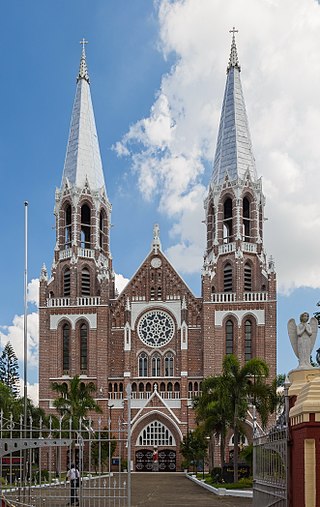
Saint Mary's Cathedral or Immaculate Conception Cathedral is a Catholic cathedral located on the corner of Bogyoke Aung San Road and Bo Aung Kyaw Street in Botahtaung Township, Yangon, Myanmar. The cathedral's exterior, of red brick, consists of spires and a bell tower. It was designed by Dutch architect Joseph Cuypers, son of Pierre Cuypers.
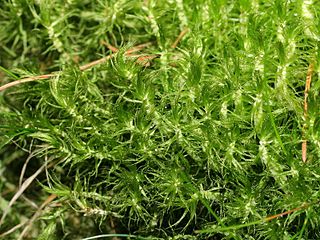
Dicranum is a genus of mosses, also called wind-blown mosses or fork mosses. These mosses form in densely packed clumps. Stems may fork, but do not branch. In general, upright stems will be single but packed together. Dicranum is distributed globally. In North America these are commonly found in Jack pine or Red pine stands.

La Meilleraye-de-Bretagne is a commune in the Loire-Atlantique department in western France.

Jean Cardot was a French sculptor, born in Saint-Étienne, France. He is known for his monumental sculptures that depict political figures and that are designed to complement particular architectural settings.
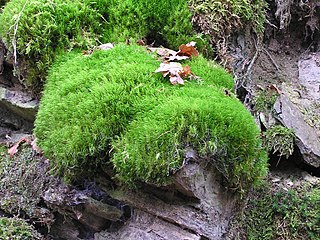
Dicranaceae is a family of haplolepideous mosses (Dicranidae) in class Bryopsida. Species within this family are dioicous. Genera in this family include Dicranum, Dicranoloma, and Mitrobryum.

Jules Cardot was a French botanist and bryologist considered in his time one of the world's leading experts on the mosses of Antarctica.
Cardot is a French surname. Notable people with the surname include:

The Pottiaceae are a family of mosses. They form the most numerous moss family known, containing nearly 1500 species or more than 10% of the 10,000 to 15,000 moss species known.

Ditrichum is a genus of haplolepideous mosses (Dicranidae) in the family Ditrichaceae.

Racomitrium is a genus of mosses in the family Grimmiaceae established in 1818 by Samuel Elisée Bridel-Brideri. It contains the following species:
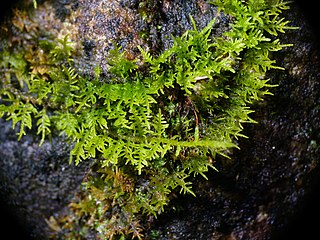
Thuidiaceae is a family of mosses within the order Hypnales. It includes many genera but the classification may need to be refined. The core genera are Thuidium, Thuidiopsis, Pelekium, Aequatoriella, Abietinella, Rauiella, Haplocladium and Actinothuidium form a clade but others currently placed in the family may belong elsewhere.
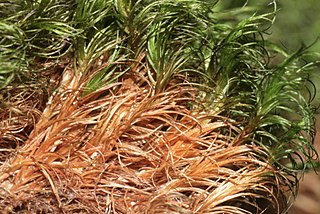
Campylopus is a genus of 180 species of haplolepideous mosses (Dicranidae) in the family Leucobryaceae. The name comes from the Greek campylos, meaning curved, and pous, meaning foot, referring to the setae which curve downwards.
Fontinalis dalecarlica is a species of moss belonging to the family Fontinalaceae.

Plagiothecium is a genus of moss belonging to the family Plagiotheciaceae. It has a cosmopolitan distribution.
Pylaisia is a genus of mosses belonging to the family Pylaisiaceae.
A statue of Winston Churchill by Jean Cardot was inaugurated in the grounds of the Petit Palais on the Avenue Winston Churchill in the 8th arrondissement of Paris in 1998. The statue of the former British prime minister is one of few statues of foreigners in the French capital.
Marie-Hélène Cardot was a French resistance leader and politician. She conducted clandestine activities, helping prisoners and guerrillas during the Second World War, in which she was twice arrested. Cardot went into politics following the end of the German occupation of France. During her political career, she served in the Council of the Republic, the Senate, of which she was vice-president from 1959 to 1971, and was mayor of Douzy for 18 years. She was a recipient of the Resistance Medal, the Croix de Guerre, the Cross of the Order of Leopold and the Chevaliers of the Légion d'honneur.
Platygyriella is a genus of moss in the family Hypnaceae. It was described by Jules Cardot in 1854. It occurs mostly in the Americas, parts of Africa, and parts of Asia.













